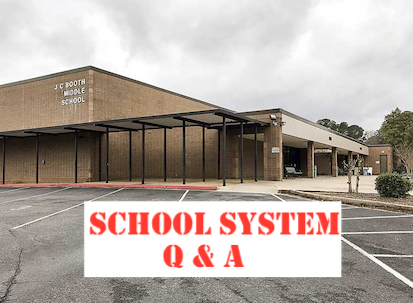School system’s answers to questions raise still more questions; changes coming to how high school students are educated in Fayette County —

The outlines of a master plan to modify the way thousands of secondary school students are educated in Fayette County are becoming clearer with the answers supplied by the school system to questions asked by two former members of the Board of Education.
The questions were sparked by the run-up to the Board of Education’s decision to replace the venerable J.C. Booth Middle School in Peachtree City and convert the old Booth into an expanded Center of Innovation school, what 50 years ago would have been called a vocational high school.
The way things have been done for the past few decades provides career and vocational training for high school students at each of the existing five high schools. That means no dual location transportation issues or shuttling from one school to another by students and teachers.
The new way would likely mean that all career training would be done at the current COI campus in the old Fayetteville Intermediate School on Hood Avenue in Fayetteville, next to Fayette County High School, and at the renovated Booth School on Peachtree Parkway South in Peachtree City.
For the most part, no career training opportunities would remain at the five high schools. That means many hundreds of students would have to shuttle between at least two campuses during the school day. How that will be accomplished, and how much it will cost, have not been explained publicly.

The decision by the Board of Education October 4 to build a new replacement middle school in eastern Peachtree City was publicly opposed by the Peachtree City Council at a Sept. 25 public hearing. The new school site is reachable now by only two roads: one a narrow dirt road (Stagecoach Road) and the other a dead-end neighborhood street (Carriage Lane).
Peachtree City Mayor Vanessa Fleisch told the school board before the vote that the city had not budgeted the “millions of dollars” that would be needed for the traffic improvements.
The school board by law can’t spend tax money to pave city streets. Right now, the school board made its decision for a new school but can’t move forward without some solution to who is going to foot the bill for the unplanned-for road upgrades and traffic improvements on Robinson Road and Ga. Highway 54.
Specific new information emerged from the school system’s answers below.
• The system administrators don’t know the operating costs of the current Hood Avenue COI. (See answer to Question 1.)
• The school system doesn’t know the anticipated cost of the expanded COI at the renovated Booth. (See answer to Question 4.)
• The school system doesn’t want to call the renovated Booth “a stand-alone vocational school,” but the renovated Booth will expand the offerings at the current COI in Fayetteville, currently cooking and health sciences classes. (See answer to Question 4.)
• Presidents at Clayton State University and Southern Crescent Technical College have said they want to expand their offerings into the renovated Booth. (See answer to Question 5.)
• The school system doesn’t know how much these future programs will cost local taxpayers at this stage. (See answer to Question 8.)
• We shouldn’t worry that the school system doesn’t know how much all this will cost because “The Fayette County Board of Education has consistently exercised strong fiduciary management and taken care of students, staff, and taxpayers while working to provide a superior quality educational service.” (See answer to Question 12.)
• Even though the school system talked for months about both a replacement plan and a renovation plan for Booth, “No architectural plans for the renovation of the existing Booth have been developed.” (See answer to Question 14.)
Below is the story reported by Ben Nelms about how we obtained the answers to the questions that first appeared as letters to the editor on TheCitizen.com.
=================================
Former long-time Fayette County Board of Education members Marion Key and Bob Todd have questioned the wisdom of building a replacement school for Booth Middle School in Peachtree City. Those questions have not stopped with the school board’s recent vote to move forward with building the replacement school on Stagecoach Road.
Key and Todd recently submitted a number of questions to Superintendent Jody Barrow pertaining both the Booth and the Center of Innovation (COI) at Fayetteville Intermediate School, which would presumably relocate to the current Booth campus once the replacement school is operational.
Those questions, and the answers provided by the administrators of the school system, are included below.
- QUESTION 1: What are the operating costs of the current COI?
ANSWER: Because costs are split between the BOE and Southern Crescent Technical College, we will need more time to calculate the costs. As soon as the figures are available, they will be provided.
- QUESTION 2: What research has been done to determine the effectiveness of the current COI?
- ANSWER:
- Testimonials – The school system responded by providing a letter of support from the mother of a COI student, statements from three students taking courses at COI and an article from The Citizen noting the value of COI to a student in the Certified Clinical Medical Assistance program.
- CTAE (Career, Technical and Agricultural Education) delivers for students:
The school system graduation rate for the past three years is higher (nearly 98 percent) for COI students than the system graduation rate (89.4 percent) and the state graduation rate (81.4 percent).
Over the last three years, 384 Fayette County students have earned an industry recognized credential through the health science and culinary programs offered at the COI (CCMA, CNA, Phlebotomy Tech, Technical College Certificate). These additional credentials beyond a high school diploma provide Fayette County’s young people with a competitive edge when applying for scholarships, entrance into health science/culinary college programs, and the workforce.
- QUESTION 3: What formal feedback do you have from the students who have completed programs there? How does having courses taught at the COI affect the course scheduling at the home high schools?
ANSWER: The answers by the school system came in three parts. The first, a), included the answers found in Question 2).
Additionally, another answer came in the form of a statement from a school counselor/COI parent. That statement read: “I find the COI to be an invaluable opportunity that our students have in Fayette County. My daughter went through the Healthcare pathway completing the CNA course. My daughter has always wanted to do something in the medical field. Taking CNA gave her experiences she would not have until junior or senior in college. These experiences not only validated her career choice but allowed to her fall in love with the field even more.
“As a school counselor, I view high school as an opportunity for students to figure out what they want to do and want they do not want to do in life. Our students have the opportunity to experience a career path instead of just hearing and talking about it. What we have in Fayette County gives those discussions true meaning.
b) The majority of COI classes are part of Georgia’s Dual Enrollment program that allows students to enroll in approved college-level coursework for credit towards both high school and college graduation requirements (Gafutures.org). For this school year, there are over 830 Fayette County students participating in the GA Dual Enrollment program taking over 1,800 courses mostly through local institutions: Southern Crescent Technical College, Clayton State University, Georgia Military College, and Point University. About 50 percent of those courses taken by Fayette County students are through the partnership between the school district and Southern Crescent Technical College. Since the state revamped the Georgia Dual Enrollment program in 2015, participation has increased by 41.4 percent.
c) Whenever there is an expansion of course offerings, there is always an impact on scheduling. The college class times don’t always align with the high school schedule; therefore, the Dual Enrollment program as a whole has impacted high school scheduling. Dual enrollment schedules don’t change when the high school schedule changes for pep rallies, assemblies, etc.
Coordinating between the college and high school as it pertains to students’ requests for changes and/or to withdraw from classes also is a challenge.
The benefit of the Dual Enrollment program is that students earn college credits that are tuition free, thereby lowering the overall cost to pursue a degree or industry certification. Some students are able to earn an associate’s degree or industry certification by the time they graduate from high school. For the college bound student, this lowers the time and money needed to acquire a degree. For students ready to enter the workforce, they do so with marketable skills and potential for higher earnings at an earlier age.
Courses at the COI are offered in instructional blocks that align with the high school day, and most COI students are enrolled in a morning block or an afternoon block, allowing for travel time between the COI and the student’s high school. A smaller number of COI students attend the mid-day block (mostly FCHS students due to proximity). An informal survey of high school principals indicates that scheduling around the COI instructional blocks is a challenge, but as one principal stated, “Ultimately, the positive impact for our students of these opportunities at the COI far outweighs the challenges for the school.”
- QUESTION 4: What will be the operating costs of a stand-alone vocational school at the current Booth building?
ANSWER: The district is not proposing a “stand-alone vocational school” but rather an expansion of our Center of Innovation. Costs will be determined by the number of program offerings that are developed and that will be done based on student interest and enrollment. In the current center, we have three pathways. (See the response in question #1 regarding operating costs).
- QUESTION 5: What guarantee do you have that Southern Crescent Technical College (SCTC) or Clayton State (CSU) will teach classes there?
ANSWER: The presidents of both institutions have expressed letters of interest to collaboratively expand their partnership with Fayette County Schools. More formal agreements will be developed as future meetings are scheduled and held.
- QUESTION 6: Why would CSU want to move out of the building they are currently in?
ANSWER: This question would need to be directed to the post-secondary institutions.
- QUESTION 7: If Southern Crescent teaches the third level of pathway courses, how will a student who does not meet SC’s admission requirements complete the pathway?
ANSWER: SCTC has various ways in which a student can meet admissions requirements: Hope GPA, PSAT, SAT, ACT, and Accuplacer. The students who choose to take a class at the COI are able to meet SCTC’s admission requirements.
- QUESTION 8: Building a replacement Booth will cost at least $50 million. How much more will it cost to upgrade the current Booth for the new programs to be offered there? How much will the operating costs be?
ANSWER: The BOE approved guaranteed maximum cost for the replacement school is $46 miillion. That figure includes all fees, construction, furniture, safety and security, etc. The operational costs of future programs cannot be determined until those program areas are selected. Again, this will be discussed during future planning and development meeting with all parties.
A firm number will not be reached until the scope of work is finalized, designed, and goes out for bid. The system will receive approximately $5.9 million from state capital outlay funds to assist with the modernization of the current Booth facility.
- QUESTION 9: It looks as if the cost of this whole project will be $60-70 million. How will these costs affect the instruction of all students in the county?
ANSWER: The instructional budget is separate from monies used for construction projects. Instructional funds will continue to support instruction.
- QUESTION 10: Teachers are already saying that they do not have the supplies and equipment that they need. How will throwing all of your eggs in one “Booth” basket affect the educational opportunities of the other students in the system?
ANSWER: The instructional budget is separate from monies used for construction projects. Instructional funds will continue to be used to provide teachers with supplies and resources. The system is already spending above the state required threshold of 65 percent in direct instructional costs. The current BOE has provided additional funding allocations in order to insure equity for all of our students, teachers and schools.
- QUESTION 11: There is a rumor going around in the school system that all CTAE courses and all AP courses will be taught in the current Booth building. Is this true? Why would the Board want to do this?
ANSWER: We typically do not respond to rumors; however, the district can share there is no such plan of action being considered or even discussed.
• QUESTION 12: Is the Board willing to roll the dice and spend $60 million on a replacement school and the renovation of the current school without knowing the final costs or whether having a stand-alone tech school is effective?
ANSWER: No response will be given to individual speculation. The Fayette County Board of Education has consistently exercised strong fiduciary management and taken care of students, staff, and taxpayers while working to provide a superior quality educational service. While individuals may not agree with all decisions that the board makes, the public can be assured great due diligence and thoughtful consideration is given to all issues, big and small, without micromanaging the day to day operations of the system.
- QUESTION 13: Is the Board willing to deny the other schools in the system their needs in order to build a replacement school that is not needed? There is a renovation plan that will give the Booth community all of its needs and will cost less than half the cost of a replacement school. There is adequate space in other facilities in the system for the COI.
ANSWER: The school system has a Five-Year Facility Plan that is developed and approved by an expert facility team selected by the SDOE, the Georgia Department of Education, and the FCBOE. Projects are developed and funded based on scope, size, urgency, and priorities of need.
- QUESTION 14: Where are the architectural plans that show what a $20 million to 22 million renovation of Booth would look like? That plan would be in keeping with the ESPLOST (education special purpose local option sales tax) promise.
ANSWER: No architectural plans for the renovation of the existing Booth have been developed. The decision to move forward with the replacement school was made on Monday, 11-4-19. The system does have renderings of possible changes to the facility, but the authorization to proceed with the complete design process would have been premature pending the board’s decision on the two options to either renovate or replace.
- QUESTION 15: Current enrollments and building capacities show that programs housed at Fayette Intermediate can be housed elsewhere. Yes or no, and why?
ANSWER: The Fayette Intermediate facility currently houses Southern Crescent Technical College programs and collaborative Fayette County pathway programs known as the Center of Innovation. In looking at future growth trends in Fayetteville, we anticipate the need for additional elementary classroom space in the near future. We do not anticipate moving the COI or programs it currently houses, until there is a legitimate reason.
- QUESTION 16: Given news reports (from AJC) that there is no evidence to support what is currently being done with CTAE programs, why the need for all students in certain programs to leave their school to complete a career path?
ANSWER: a) Our research of AJC news reports on CTAE programs indicates that there needs to be an alignment of CTAE programs and local workforce demands (AJC, 04.04.2019). At the COI, students have access to multiple healthcare programs – Allied Health, Medical Assistant, Patient Care, Emergency Medical Responder, Emergency Medical Technician (SY21), Phlebotomy.
This directly supports the growth in the healthcare industry in Fayette County as well as in the metro Atlanta area. The culinary arts program supports the hospitality industry by producing students with culinary skills and Safe Serve certification. The film course supports the creative industries by developing skills in film production and editing. Next year, Information Technology courses will be offered at the COI, giving students skills in computer science, another growth industry for Georgia.
Another AJC article (AJC, 08.03.2019) cites a study that supports a pathway approach to CTAE, with students who complete upper level CTAE classes having an advantage in their earnings and in college completion should they enroll in a post-secondary program.
b) In looking at system budgeting and finance for program offerings, some programs of student interest and/or the need for industry workforce development do not support stand alone programs at individual high schools; however, in order to serve a few students at multiple high schools, the program(s) can be offered at a centralized setting (COI) so the school district can economically afford to meet student interest and workforce needs, and to be good stewards of the taxpayers dollars. The Health Science pathway is a perfect example of this.
Prior to the opening of the COI, Fayette County high schools were able to offer only one Level III health science course (Allied Health). In addition, high schools did not have the capacity to meet the growing student demand for the Health Science pathway.
Currently, Level I and Level II health science courses are taught at the student’s base high school. Having the Level III courses taught at the COI allows Fayette County to expand Level III course offerings to include Allied Health, Emergency Medical Responder, Emergency Medical Technician (new for School Year 2021), Patient Care and Phlebotomy.
With the opening of the COI and our partnership with Southern Crescent Technical College, Fayette County’s Level III health science student numbers have increased from 62 students in 2014 to currently serving 253 health science students — representing a 75.5% increase. Since the 2016-2017 school year, 341 students have earned an industry credential through the Health Science pathway at the COI.
Through the FCBOE/SCTC partnership, Fayette County students are able to earn high school credit, technical college credit, a technical college certificate, and a healthcare industry credential in a field of the student’s passion.
After finishing the pathway, some students continue in internships or work-based learning in healthcare, giving students clinical experience before entering college. These additional credentials beyond a high school diploma provide Fayette County’s young people with a competitive edge when applying for scholarships and entrance into health science college programs and the workforce. With industry certification, students can find employment in the healthcare sector while continuing their college education, perhaps helping to defray the cost of tuition and student debt.
• QUESTION 17: A school board that wants to further develop and strengthen CTAE programs would use extensive research and input to determine program and facility needs. Where is the evidence that this has been done? Shouldn’t this have been done before large expenditures for facilities are made?
ANSWER: a) Here is a research report that supports the pathway approach to CTAE: Depth Over Breadth
b) Perkins V information that shows how our CTAE pathway choices must be based on workforce development data. Under this new legislation, districts MUST conduct a local needs assessment. One of the requirements for the Comprehensive Needs Assessment found on page 209 of “The Comprehensive Guide to the Federal Role in Career & Technical Education: Perkins V and the Uniform Grant Guidance” states: “a description of how career and technical education programs offered by the eligible recipient are – (ii)(I) aligned to State, regional, Tribal, or local in-demand industry sectors or occupations identified by the State workforce development board described in section 101 of the Workforce Innovation and Opportunity Act (29 U.S.C. 3111) (referred to in this section as the ‘State Board’) or local workforce boards.”
— Reported by BEN NELMS













Leave a Comment
You must be logged in to post a comment.